Solar eclipse of February 16, 1999
An annular solar eclipse occurred on February 16, 1999. A solar eclipse occurs when the Moon passes between Earth and the Sun, thereby totally or partly obscuring the image of the Sun for a viewer on Earth. An annular solar eclipse occurs when the Moon's apparent diameter is smaller than the Sun's, blocking most of the Sun's light and causing the Sun to look like an annulus (ring). An annular eclipse appears as a partial eclipse over a region of the Earth thousands of kilometres wide. Annularity was visible in the southern Indian Ocean including the Prince Edward Islands, South Africa (the northern part of Marion Island and the whole Prince Edward Island), and Australia.
Images

Related eclipses
Eclipses of 1999
- A penumbral lunar eclipse on January 31.
- An annular solar eclipse on February 16.
- A partial lunar eclipse on July 28.
- A total solar eclipse on August 11.
Solar eclipses 1997–2000
This eclipse is a member of a semester series. An eclipse in a semester series of solar eclipses repeats approximately every 177 days and 4 hours (a semester) at alternating nodes of the Moon's orbit.[1]
| Descending node | Ascending node | |||||
|---|---|---|---|---|---|---|
| Saros | Map | Gamma | Saros | Map | Gamma | |
120 Chita, Russia | 1997 March 09 Total | 0.91830 | 125 | 1997 September 02 Partial (south) | −1.03521 | |
130 Total eclipse near Guadeloupe | 1998 February 26 Total | 0.23909 | 135 | 1998 August 22 Annular | −0.26441 | |
| 140 | 1999 February 16 Annular | −0.47260 | 145 Totality from France | 1999 August 11 Total | 0.50623 | |
| 150 | 2000 February 05 Partial (south) | −1.22325 | 155 | 2000 July 31 Partial (north) | 1.21664 | |
Partial solar eclipses on July 1, 2000 and December 25, 2000 occur in the next lunar year eclipse set.
Saros 140
It is a part of Saros cycle 140, repeating every 18 years, 11 days, containing 71 events. The series started with partial solar eclipse on April 16, 1512. It contains total eclipses from July 21, 1656 through November 9, 1836, hybrid eclipses from November 20, 1854 through December 23, 1908, and annular eclipses from January 3, 1927 through December 7, 2485. The series ends at member 71 as a partial eclipse on June 1, 2774. The longest duration of totality was 4 minutes, 10 seconds on August 12, 1692.
| Series members 23–53 occur between 1901 and 2450: | ||
|---|---|---|
| 23 | 24 | 25 |
 Dec 23, 1908 |  Jan 3, 1927 |  Jan 14, 1945 |
| 26 | 27 | 28 |
 Jan 25, 1963 |  Feb 4, 1981 |  Feb 16, 1999 |
| 29 | 30 | 31 |
 Feb 26, 2017 |  Mar 9, 2035 |  Mar 20, 2053 |
| 32 | 33 | 34 |
 Mar 31, 2071 |  Apr 10, 2089 |  Apr 23, 2107 |
| 35 | 36 | 37 |
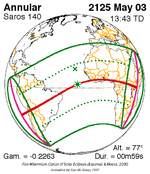 May 3, 2125 | 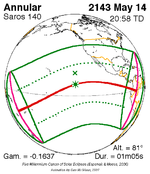 May 14, 2143 | 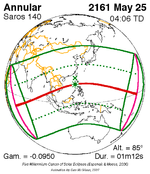 May 25, 2161 |
| 38 | 39 | 40 |
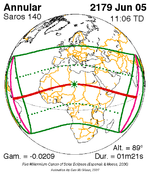 Jun 5, 2179 |  Jun 15, 2197 |  Jun 28, 2215 |
| 41 | 42 | 43 |
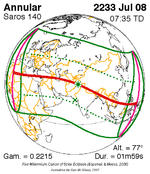 Jul 8, 2233 | 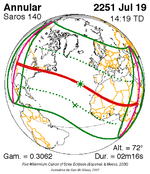 Jul 19, 2251 | 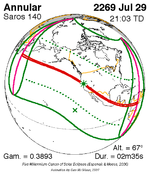 Jul 29, 2269 |
| 44 | 45 | 46 |
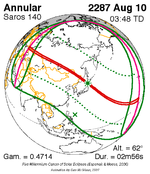 Aug 10, 2287 | 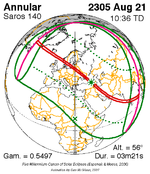 Aug 21, 2305 |  Sep 1, 2323 |
| 47 | 48 | 49 |
 Sep 12, 2341 | 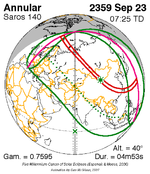 Sep 23, 2359 |  Oct 3, 2377 |
| 50 | 51 | 52 |
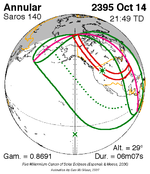 Oct 14, 2395 | 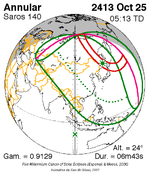 Oct 25, 2413 |  Nov 5, 2431 |
| 53 | ||
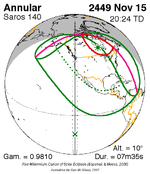 Nov 15, 2449 | ||
Metonic series
The metonic series repeats eclipses every 19 years (6939.69 days), lasting about 5 cycles. Eclipses occur in nearly the same calendar date. In addition, the octon subseries repeats 1/5 of that or every 3.8 years (1387.94 days). All eclipses in this table occur at the Moon's descending node.
| 21 eclipse events, progressing from north to south between July 11, 1953 and July 11, 2029 | ||||
|---|---|---|---|---|
| July 10–12 | April 29–30 | February 15–16 | December 4–5 | September 21–23 |
| 116 | 118 | 120 | 122 | 124 |
 July 11, 1953 |  April 30, 1957 |  February 15, 1961 |  December 4, 1964 |  September 22, 1968 |
| 126 | 128 | 130 | 132 | 134 |
 July 10, 1972 |  April 29, 1976 |  February 16, 1980 |  December 4, 1983 |  September 23, 1987 |
| 136 | 138 | 140 | 142 | 144 |
 July 11, 1991 |  April 29, 1995 |  February 16, 1999 |  December 4, 2002 |  September 22, 2006 |
| 146 | 148 | 150 | 152 | 154 |
 July 11, 2010 |  April 29, 2014 |  February 15, 2018 |  December 4, 2021 |  September 21, 2025 |
| 156 | 158 | 160 | 162 | 164 |
 July 11, 2029 | ||||
Notes
- ^ van Gent, R.H. "Solar- and Lunar-Eclipse Predictions from Antiquity to the Present". A Catalogue of Eclipse Cycles. Utrecht University. Retrieved 6 October 2018.
References
- Earth visibility chart and eclipse statistics Eclipse Predictions by Fred Espenak, NASA/GSFC
- Google interactive map
- Besselian elements
- v
- t
- e
| By era | |
|---|---|
| Saros series | |
| Visibility | |
| Historical |
|

Total/hybrid eclipses
→ next total/hybrid
- 1560
- 1598
- 1652
- 1654
- 1673
- 1699
- 1706
- 1715
- 1724
- 1766
- 1778
- 1780
- 1806
- 1816
- 1824
- 1842
- 1851
- 1853
- 1857
- 1858
- 1860
- 1865
- 1867
- 1868
- 1869
- 1870
- 1871
- 1874
- 1875
- 1878
- 1882
- 1883
- 1885
- 1886
- 1887
- Jan 1889
- Dec 1889
- 1893
- 1896
- 1898
- 1900
- 1901
- 1903
- 1904
- 1905
- 1907
- Jan 1908
- Dec 1908
- 1909
- 1910
- 1911
- Apr 1912
- Oct 1912
- 1914
- 1916
- 1918
- 1919
- 1921
- 1922
- 1923
- 1925
- 1926
- 1927
- 1928
- 1929
- Apr 1930
- Oct 1930
- 1932
- 1934
- 1936
- 1937
- 1938
- 1939
- 1940
- 1941
- 1943
- Jan 1944
- 1945
- 1947
- 1948
- 1950
- 1952
- 1954
- 1955
- 1956
- 1957
- 1958
- 1959
- 1961
- 1962
- 1963
- 1965
- 1966
- 1967
- 1968
- 1970
- 1972
- 1973
- 1974
- 1976
- 1977
- 1979
- 1980
- 1981
- 1983
- 1984
- 1985
- 1986
- 1987
- 1988
- 1990
- 1991
- 1992
- 1994
- 1995
- 1997
- 1998
- 1999
- 2001
- 2002
- 2003
- 2005
- 2006
- 2008
- 2009
- 2010
- 2012
- 2013
- 2015
- 2016
- 2017
- 2019
- 2020
- 2021
- 2023
- → 2024
- 2026
- 2027
- 2028
- 2030
- 2031
- 2033
- 2034
- 2035
- 2037
- 2038
- 2039
- 2041
- 2042
- 2043
- 2044
- 2045
- 2046
- 2048
- 2049
- 2050
- 2052
- 2053
- 2055
- Jan 2057
- Dec 2057
- 2059
- 2060
- 2061
- 2063
- 2064
- 2066
- 2067
- 2068
- 2070
- 2071
- 2072
- 2073
- 2075
- 2076
- 2077
- 2078
- 2079
- 2081
- 2082
- 2084
- 2086
- 2088
- 2089
- 2090
- 2091
- 2093
- 2094
- 2095
- 2096
- 2097
- 2099
- 2100
- 2114
- 2117
- 2126
- 2132
- 2150
- 2153
- 2168
- 2178
- 2186

Annular eclipses
→ next annular
- 1820
- 1854
- 1879
- 1889
- 1900
- 1901
- 1903
- 1904
- 1905
- 1907
- 1908
- 1911
- 1914
- Feb 1915
- Aug 1915
- 1916
- 1917
- 1918
- 1919
- 1921
- 1922
- 1923
- 1925
- 1926
- 1927
- 1929
- 1932
- Feb 1933
- Aug 1933
- 1934
- 1935
- 1936
- 1937
- 1939
- 1940
- 1941
- 1943
- Jul 1944
- 1945
- 1947
- 1948
- 1950
- Mar 1951
- Sep 1951
- 1952
- Jan 1954
- Dec 1954
- 1955
- 1957
- 1958
- 1959
- 1961
- 1962
- 1963
- 1965
- 1966
- Mar 1969
- Sep 1969
- 1970
- 1972
- Jan 1973
- Dec 1973
- 1976
- 1977
- 1979
- 1980
- 1981
- 1983
- 1984
- 1987
- 1988
- 1990
- 1991
- 1992
- 1994
- 1995
- 1998
- 1999
- 2001
- 2002
- 2003
- 2005
- 2006
- 2008
- 2009
- 2010
- 2012
- 2013
- 2014
- 2016
- 2017
- 2019
- 2020
- 2021
- 2023
- → 2024
- 2026
- 2027
- 2028
- 2030
- 2031
- 2032
- 2034
- 2035
- 2036
- Jan 2038
- Jul 2038
- 2039
- 2041
- 2042
- 2043
- 2044
- 2045
- 2046
- 2048
- 2049
- 2052
- 2053
- Jan 2056
- Jul 2056
- 2057
- 2059
- 2060
- 2061
- 2063
- 2064
- 2066
- 2067
- 2070
- 2071
- Jan 2074
- Jul 2074
- 2075
- 2077
- 2078
- 2079
- 2081
- 2082
- 2084
- Jun 2085
- Dec 2085
- 2088
- 2089
- Feb 2092
- Aug 2092
- 2093
- 2095
- 2096
- 2097
- 2099
- 2100
- 2101
- Jan 2168
- Dec 2168
- Apr 2191
- 2200

Partial eclipses
→ next partial
- Jan 1639
- Apr 1902
- May 1902
- Oct 1902
- Feb 1906
- Jul 1906
- Aug 1906
- Dec 1909
- Nov 1910
- Apr 1913
- Aug 1913
- Sep 1913
- Dec 1916
- Jan 1917
- Jun 1917
- Jul 1917
- May 1920
- Nov 1920
- Mar 1924
- Jul 1924
- Aug 1924
- Dec 1927
- Jun 1928
- Nov 1928
- Apr 1931
- Sep 1931
- Oct 1931
- Jan 1935
- Feb 1935
- Jun 1935
- Jul 1935
- Nov 1938
- Mar 1942
- Aug 1942
- Sep 1942
- Jan 1946
- May 1946
- Jun 1946
- Nov 1946
- Apr 1949
- Oct 1949
- Feb 1953
- Jul 1953
- Aug 1953
- Dec 1956
- Mar 1960
- Sep 1960
- Jan 1964
- Jun 1964
- Jul 1964
- Dec 1964
- May 1967
- Mar 1968
- Feb 1971
- Jul 1971
- Aug 1971
- Dec 1974
- May 1975
- Nov 1975
- Apr 1978
- Oct 1978
- Jan 1982
- Jun 1982
- Jul 1982
- Dec 1982
- May 1985
- Apr 1986
- Mar 1989
- Aug 1989
- Dec 1992
- May 1993
- Nov 1993
- Apr 1996
- Oct 1996
- Sep 1997
- Feb 2000
- 1 Jul 2000
- 31 Jul 2000
- Dec 2000
- Apr 2004
- Oct 2004
- Mar 2007
- Sep 2007
- Jan 2011
- Jun 2011
- Jul 2011
- Nov 2011
- Oct 2014
- Sep 2015
- Feb 2018
- Jul 2018
- Aug 2018
- Jan 2019
- Apr 2022
- Oct 2022
- → Mar 2025
- Sep 2025
- Jan 2029
- Jun 2029
- Jul 2029
- Dec 2029
- 2032
- 2033
- Feb 2036
- Jul 2036
- Aug 2036
- 2037
- May 2040
- Nov 2040
- Jan 2047
- Jun 2047
- Jul 2047
- Dec 2047
- 2050
- Apr 2051
- Oct 2051
- Mar 2054
- Aug 2054
- Sep 2054
- 2055
- May 2058
- Jun 2058
- Nov 2058
- Mar 2062
- Sep 2062
- Feb 2065
- Jul 2065
- Aug 2065
- Dec 2065
- 2068
- Apr 2069
- May 2069
- Oct 2069
- 2072
- 2073
- Jun 2076
- Jul 2076
- Nov 2076
- Feb 2083
- Jul 2083
- Aug 2083
- 2084
- 2086
- May 2087
- Jun 2087
- Oct 2087
- 2090
- 2091
- Jun 2094
- Jul 2094
- Dec 2094
- Apr 2098
- Sep 2098
- Oct 2098
- Apr 2108
- Jul 2195
 Astronomy portal
Astronomy portal Solar System portal
Solar System portal Category
Category
 | This solar eclipse–related article is a stub. You can help Wikipedia by expanding it. |
- v
- t
- e














